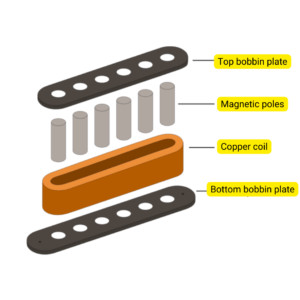Electric guitars sing thanks to their pickups. Unlike acoustic guitars that rely on natural resonance, electric guitars use electromagnetic magic to translate string vibrations into the sounds we love. But with so many types of guitar pickups available, understanding their differences is crucial for shaping your tone. This guide will dive deep into the world of Guitar Pickup Types, helping you discern the nuances and choose the perfect pickups for your musical journey.
It’s essential to remember that no single pickup type reigns supreme. The “best” guitar pickup is subjective and depends entirely on your desired sound and playing style. Just like tonewoods influence an acoustic guitar’s voice, pickups are fundamental to an electric guitar’s sonic character. Let’s explore the three foundational types of pickups that form the bedrock of electric guitar sound.
1. Single-Coil Pickups: Clarity and Brightness
 Fender Stratocaster single coil pickups close up showing pole pieces
Fender Stratocaster single coil pickups close up showing pole pieces
The single-coil pickup is where it all began. Emerging from early designs like the “horseshoe” pickup of the 1930s, the single-coil is the most fundamental electric guitar pickup. Its design is elegantly simple yet effective: magnetic poles, typically one for each string, are positioned between bobbin plates. These poles are then wrapped with a copper wire coil. This coil and magnet configuration creates a magnetic field. When your guitar strings vibrate within this field, they cause disturbances. The copper coil then converts these magnetic fluctuations into a weak electrical signal. This signal travels through your guitar cable to your amplifier, where it’s boosted and projected through your speakers as glorious guitar sound.
Single-coil pickups are renowned for their bright, clear, and articulate tone. They excel at capturing the high frequencies, making them ideal for genres where clarity and definition are paramount. Think sparkling cleans, crisp country twang, and articulate funk rhythms. Fender Stratocasters and Telecasters, iconic guitars synonymous with surf rock and country music, are famously equipped with single-coil pickups. You can even spot a classic single-coil in the neck position of the Stratocaster pictured at the beginning of this article.
However, single-coils have a well-known Achilles’ heel: noise. Their very design makes them susceptible to picking up unwanted electromagnetic interference. This can manifest as hum from power sources, radio waves, and other ambient electrical noise, often referred to as “60-cycle hum.” While this hum can sometimes be part of the vintage charm, it can also be a significant annoyance, especially at higher volumes or in electrically noisy environments. This very issue spurred the invention of the humbucker, our next pickup type.
2. Humbucker Pickups: Power and Warmth
 Gibson Les Paul humbucker pickups showing dual coils
Gibson Les Paul humbucker pickups showing dual coils
The humbucker pickup emerged in the 1950s as a clever solution to the single-coil’s noise problem. The ingenious design of the humbucker, as the name suggests, is to “buck the hum.” It achieves this by using two coils instead of one. These two coils are positioned next to each other, but with reversed magnetic polarity and wound in opposite directions. This configuration is the magic behind hum cancellation. The hum picked up by each coil is out of phase, effectively canceling each other out, resulting in a significantly quieter signal.
But humbuckers are not just about noise reduction; they also possess a distinct tonal character. Popularized by Gibson guitars, particularly the legendary Les Paul, humbuckers deliver a thicker, warmer, and more powerful sound compared to single-coils. They boast a stronger midrange presence and a smoother high-end response. This tonal profile makes humbuckers exceptionally well-suited for higher gain applications. They handle distortion and overdrive with aplomb, making them the go-to choice for rock, hard rock, and metal genres.
While humbuckers excel in high-gain scenarios, they can sometimes sound less articulate than single-coils when played clean, potentially leaning towards a “muddy” tone, especially in the neck position. However, this characteristic can also be a virtue. In jazz music, for example, humbuckers are often favored for their warm, full-bodied tone and smooth response, providing a rich and mellow sound ideal for jazz harmonies and improvisations.
3. P-90 Pickups: The Best of Both Worlds?
 Gibson P90 pickup showing wider single coil design
Gibson P90 pickup showing wider single coil design
For guitarists seeking a middle ground between the bright clarity of single-coils and the powerful warmth of humbuckers, the P-90 pickup emerges as a compelling option. While technically still a single-coil pickup, the P-90 distinguishes itself through its unique construction. It utilizes a wider bobbin, meaning the copper wire coil is wound over a broader area and positioned further from the magnetic poles compared to traditional single-coils.
This design results in a pickup that retains some of the brightness and articulation of a single-coil but also incorporates a degree of the warmth and output associated with humbuckers. P-90s offer a punchier, thicker tone than standard single-coils, with a healthy dose of midrange growl. They can handle higher levels of distortion than typical single-coils, making them versatile for genres beyond just clean playing. Yet, they still retain clarity and responsiveness when used with clean amp settings.
Developed by Gibson as an alternative to their earlier Charlie Christian pickup (famously used on the ES-150 jazz guitar), P-90s have proven their versatility across genres. While initially associated with jazz, their balanced tonal character has made them popular in rock, blues, country, and even punk music. They offer a unique sonic footprint that sits comfortably between the classic tones of single-coils and humbuckers, making them a favorite for guitarists seeking a distinctive and versatile sound.
Choosing the Right Pickup Type for Your Sound
Selecting the right guitar pickup type is a crucial step in shaping your electric guitar tone. Consider these factors when making your choice:
-
Musical Genre: Are you primarily playing blues, country, and funk? Single-coils might be your ideal choice for their clarity and twang. Rock, metal, and heavier styles often benefit from the power and warmth of humbuckers. P-90s can be a great all-around option for rock, blues, and genres requiring versatility.
-
Desired Tone: Do you crave bright, sparkling highs and articulate note definition? Single-coils are your friend. Looking for a warm, thick, and powerful sound with strong midrange? Humbuckers are the way to go. Want a balance of both worlds with added punch? Explore P-90s.
-
Guitar and Wood Type: The inherent tonal characteristics of your guitar and its tonewoods also play a role. A brighter guitar might pair well with warmer humbuckers, while a darker guitar could benefit from the clarity of single-coils. Experimentation is key!
-
Playing Style: Aggressive players who dig in hard might appreciate the higher output and sustain of humbuckers. Players with a lighter touch who value nuance and dynamics might find single-coils more responsive.
-
Noise Considerations: If you frequently play in environments with electrical noise, humbuckers are a practical choice to minimize unwanted hum. Noise-canceling single-coil designs also exist as a compromise.
Ultimately, the best way to discover your preferred pickup type is to try different guitars equipped with various pickups. Visit your local guitar store, experiment with different models, and listen carefully to the nuances of each pickup type. Your ears are your best guide in the quest for the perfect guitar tone.
(Optional: Add a Call to Action like in the original article, adapted for guitarplayers.net, e.g., “Explore more guitar gear reviews and guides on guitarplayers.net.”)

